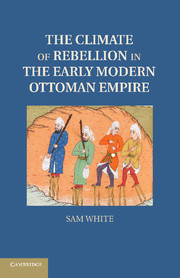Book contents
- Frontmatter
- Contents
- Acknowledgments
- Preface
- Glossary of Ottoman Terms
- Maps
- Introduction
- Part I An Imperial Ecology
- Part II The Little Ice Age Crisis
- 5 The Little Ice Age in the Near East
- 6 The Great Drought
- 7 The Celali Rebellion
- 8 In the Wake of the Celalis
- Part III Ecological Transformation
- Conclusion
- Bibliography
- Index
- References
8 - In the Wake of the Celalis
Climate and Crisis in the Seventeenth Century
Published online by Cambridge University Press: 05 February 2012
- Frontmatter
- Contents
- Acknowledgments
- Preface
- Glossary of Ottoman Terms
- Maps
- Introduction
- Part I An Imperial Ecology
- Part II The Little Ice Age Crisis
- 5 The Little Ice Age in the Near East
- 6 The Great Drought
- 7 The Celali Rebellion
- 8 In the Wake of the Celalis
- Part III Ecological Transformation
- Conclusion
- Bibliography
- Index
- References
Summary
Following the Celali Rebellion, another century of natural and human disasters prolonged Ottoman troubles and derailed the empire's recovery. Little Ice Age climate fluctuations brought recurring extremes of temperature and precipitation through the mid-1600s, playing a major role in the empire's chronic political instability and rural disorder. Then in the last decades of the seventeenth century, the Ottoman Empire underwent another conjuncture of severe weather, military setbacks, and internal disorder. By around 1710, once the worst of the Little Ice Age had passed, Istanbul had witnessed the deposition of five sultans, and many of the core provinces were left in much the same poor condition as a century before, in the wake of the Celali Rebellion.
- Type
- Chapter
- Information
- The Climate of Rebellion in the Early Modern Ottoman Empire , pp. 187 - 226Publisher: Cambridge University PressPrint publication year: 2011

